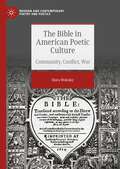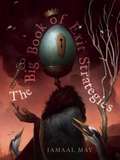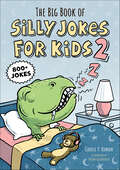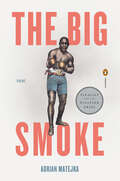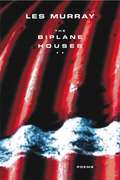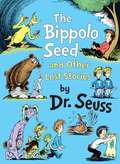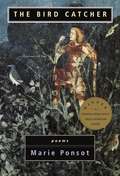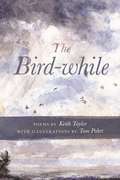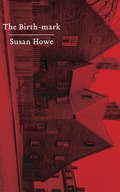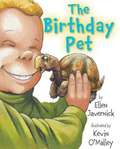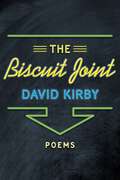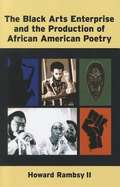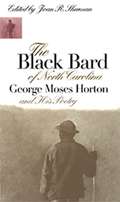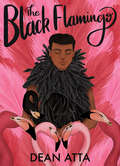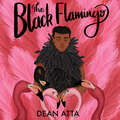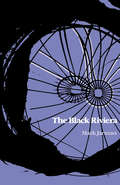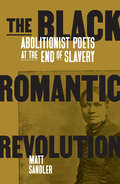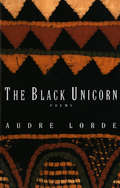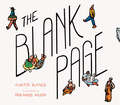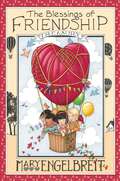- Table View
- List View
The Bible in American Poetic Culture: Community, Conflict, War (Modern and Contemporary Poetry and Poetics)
by Shira WoloskyAlthough the Bible is the foundation of American poetic tradition, there is no study of the Bible as an ongoing force in American poetry. Not only a source of imagery, allusion, rhythm and style, the Bible is central to how poetry has both shaped and been shaped by American civic, political, and social history, including issues of ethnicity, race and gender. Through poetry core issues of the Bible in American culture emerge in a new light. What defines America as a nation? What are its historical, political and religious meanings and direction? Vitally, how is it that the Bible is at once a shared common text, binding community, and yet was throughout American culture also contested, disputed, and politicized as a weapon of war? This study begins with the Puritans, and goes on to examine poetry of the Revolutionary and Civil Wars, as well as claims and counterclaims in abolition, slavery, and women’s rights. In doing so it treats both popular and major writers, including Edward Taylor, Frances Harper, Emerson, Whitman, Dickinson, Moore and Gwendoln Brooks, concluding with Amanda Gorman.
The Big Book of Exit Strategies
by Jamaal MayPraise for Jamaal May:"Linguistically acrobatic [and] beautifully crafted. . . . [Jamaal May's] poems, exquisitely balanced by a sharp intelligence mixed with earnestness, makes his debut a marvel."--Publishers WeeklyFollowing Jamaal May's award-winning debut collection, Hum (2013), these new poems explore parallel landscapes of the poet's interior and an insidious American condition. Using dark humor that helps illuminate the pains of maturity and loss of imagination, May uncovers language like a skilled architect--digging up bones of the past to expose what lies beneath the surface of the fragile human condition.From: "Ask Where I've Been":Ask about the tornado of fists.The blows landed. If you canwatch it all--the spit and blood frozenagainst snow, you can probably tellI am the too-narrow road winding outof a crooked city built of laughter,abandon, feathers and drums.Ask only if you can watch streetlights bow,bridges arc, and power lines sag,and still believe what matters mostis not where I bendbut where I am growing.Jamaal May is a poet, editor, and filmmaker from Detroit, Michigan, where he taught poetry in public schools and worked as a freelance audio engineer and touring performer. His poetry won the 2013 Indiana Review Poetry Prize and appears in journals such as Poetry, Ploughshares, the Believer, NER, and the Kenyon Review. May has earned an MFA from Warren Wilson College as well as fellowships from Cave Canem and The Stadler Center for Poetry at Bucknell University. He founded the Organic Weapon Arts Chapbook Press.
The Big Book of Silly Jokes for Kids 2: 800+ Jokes (Silly Jokes)
by Carole P. Roman800+ More silly jokes for kids 6 to 12 to keep them laughing!Calling all comedians! This is the super silly joke-book sequel you've been waiting for! Welcome to The Big Book of Silly Jokes for Kids 2—the second installment in this best-selling kid's humor series that's guaranteed to make you a local legend—or, at least, the cleverest coyote on your block!Inside, you'll find hundreds of clean and corny jokes for kids, including knee-slappin' knock-knocks, side-splitting puns, rib-tickling riddles, and a whole lot more! All reading levels are sure to love it on long car rides, family vacations, and around the house. There's also a joke-writing chapter in the back to create your own laughs!The Big Book of Silly Jokes for Kids 2 features:Jokes galore—Discover family-friendly jokes for kids in every format that are sure to tickle your funny bone!Hilarious images—LOL-funny illustrations make reading engaging for all ages.Fun facts, too!—In every chapter, you'll find Silly Stats to learn a little as you laugh.You're sure to become the toast of the town with The Big Book of Silly Jokes for Kids 2!
The Big Smoke
by Adrian MatejkaA finalist for both the Pulitzer Prize and the National Book Award in Poetry--a collection that examines the myth and history of the prizefighter Jack Johnson The legendary Jack Johnson (1878-1946) was a true American creation. The child of emancipated slaves, he overcame the violent segregationism of Jim Crow, challenging white boxers--and white America--to become the first African-American heavyweight world champion. The Big Smoke, Adrian Matejka's third work of poetry, follows the fighter's journey from poverty to the most coveted title in sports through the multi-layered voices of Johnson and the white women he brazenly loved. Matejka's book is part historic reclamation and part interrogation of Johnson's complicated legacy, one that often misremembers the magnetic man behind the myth.
The Biggest Snowball Fight!
by Angela Shelf MedearisA snowball fight leads to a new dance and starts a new town tradition. picture descriptions added.
The Biplane Houses
by Les MurrayThis is Les Murray's first new volume of poems since Poems the Size of Photographs in 2002. In it we find Murray at his nearmiraculous best. The collection-named for a kind of house distinctive to Murray's native Australia-exhibits both his unfailing grace as a writer and his ability to write in any voice, style, or genre: there are story poems, puns extended to poem length, history-and myths in miniature, aphoristic fragments, and domestic portraits. As ever, Murray's evocation of the natural world is unparalleled in its inventiveness and virtuosity. The Biplane Houses is ardent, eloquent, enchanting poetry.
The Bippolo Seed and Other Lost Stories
by Dr SeussSeuss scholar/collector Charles D. Cohen has hunted down seven rarely seen stories by Dr. Seuss, originally published in magazines between 1950 and 1951. In an Introduction to the collection, Cohen explains the significance these seven stories have, not only as lost treasures, but as transitional stories in Dr. Seuss's career.
The Bird Catcher: Poems
by Marie PonsotIn 1998, Marie Ponsot was awarded the National Book Critics Circle Award for poetry, confirming the praise that has been bestowed on her by critics and peers--among them Eavan Boland and Carolyn Kizer (who are quoted on the back of the book jacket) and Amy Clampitt, who had this to say of Ponsot's last book: "She is marvelously attuned to the visual and to the audible. She is no less precisely a geographer of the interior life, above all the experience of being a woman."From the Trade Paperback edition.
The Bird-while (Made in Michigan Writers Series)
by Keith Taylor“A Bird-while. In a natural chronometer, a Bird-while may be admitted as one of the metres, since the space most of the wild birds will allow you to make your observations on them when they alight near you in the woods, is a pretty equal and familiar measure” (Ralph Waldo Emerson’s Journal, 1838). Without becoming didactic or pedantic about the spiritual metaphor hidden in the concept of the “bird-while,” Keith Taylor’s collection evokes certain Eastern meditative poets who often wrote in an aphoristic style of the spirit or the mind mirroring specific aspects of the natural world. The Bird-while is a collection of forty-nine poems that meditate on the nature—both human and non-human—that surrounds us daily. Taylor is in the company of naturalist poets such as Gary Snyder and Mary Oliver—poets who often drew from an Emersonian sensibility to create art that awakens the mind to its corresponding truths in the natural world. The book ranges from the longer poem to the eight line, unrhymed stanza similar to that of the T'ang poet Han-Shan. And without section breaks to reinforce the passing of time, the collection creates greater fluidity of movement from one poem to the next, as if there is no beginning or end, only an eternal moment that is suspended on the page. Tom Pohrt’s original illustrations are scattered throughout the text, adding a stunning visual element to the already vivid language. The book moves from the author’s travel accounts to the destruction of the natural world, even species extinction, to more hopeful poems of survival and the return of wildness. The natural rhythm is at times marred by the disturbances of the twenty-first century that come blaring into these meditations, as when a National Guard jet rumbles over the treeline upsetting a hummingbird, and yet, even the hummingbird is able to regain its balance and continue as before. At its core, Taylor’s collection is a reminder of Emerson’s idea that natural facts are symbols of spiritual facts. These well-crafted poems will be easily accessible to any literary audience, with a more particular attraction to readers of contemporary poetry sensitive to the marriage of an Eastern sensibility with contemporary American settings and scenes.
The Birth-mark: Essays
by Susan HoweSusan Howe's classic groundbreaking exploration of early American literature. Susan Howe reads our intellectual inheritance as a series of civil wars, where eachtext is a wilderness in which a strange lawless author confronts interpreters, professors, and editors eager for settlement. Howe approaches Anne Hutchinson, Mary Rowlandson, Cotton Mather, Hawthorne, Emerson, Melville and Emily Dickinson as a fellow writer--as a poet and feminist as much as a critic: her insights, fierce and original, are rooted in her seminal textural scholarship in examination of their editorial histories of landmark works. In the process, Howe uproots settled institutionalized roles of men and women as well as of poetry and prose.
The Birthday Moon
by Lois DuncanRelates the wonderful things you can do with the perfect birthday gift--the moon.
The Birthday Pet
by Ellen JavernickIt was Danny's birthday, and his folks said he could get any kind of animal he wanted for a pet. Danny thought it over before he went to bed. "All I really want is a turtle," he said. But instead, his family got him . . . Read on to find out!
The Biscuit Joint: Poems (Walter Lynwood Fleming Lectures in Southern History)
by Professor David KirbyPraise for David Kirby "Kirby is exuberant, irrepressible, maniacal and remarkably entertaining.... Okay, let me just say it: he is a wonderful poet." -- Steve Kowit, San Diego Union-Tribune"Kirby's voice and matter (teaching, literature, traveling, rock 'n' roll, everyday bozohood) are utterly personal and, despite all the laughter, ultimately moving." -- Ray Olson, Booklist"[Kirby] is a poet who peels away the layers of our skin to show us who we are: our weaknesses, our strengths, and our hilarious obsessions." -- Micah Zevin, New Pages"The world that Kirby takes into his imagination and the one that arises from it merge to become a creation like no other, something like the world we inhabit but funnier and more full of wonder and terror." -- Philip Levine, Ploughshares"These poems may be too cool for words." -- Carol Muske-Dukes, New York Times Book ReviewInspired by the carpenter's biscuit joint -- a seamless, undetectable fit between pieces of wood -- David Kirby's latest collection dramatizes the artistic mind as a hidden connection that links the mundane with the remarkable. Even in our most ordinary actions, Kirby shows, there lies a wealth of creative inspiration: "the poem that is written every day if we're there / to read it."Well known for his garrulous and comic musings, Kirby follows a wandering yet calculated path. In "What's the Plan, Artists?" a girl's yawning in a picture gallery leads him to meditations on subjects as diverse as musical composition, the less-than-beautiful human figure, and "the simple pleasures / of living." The Biscuit Joint traverses seemingly random thoughts so methodically that the journey from beginning to end always proves satisfying and surprising.
The Black Arts Enterprise And The Production Of African American Poetry
by Howard RambsyThe outpouring of creative expression known as the Black Arts Movement of the 1960s and 1970s spawned a burgeoning number of black-owned cultural outlets, including publishing houses, performance spaces, and galleries. Central to the movement were its poets, who in concert with editors, visual artists, critics, and fellow writers published a wide range of black verse and advanced new theories and critical approaches for understanding African American literary art. The Black Arts Enterprise and the Production of African American Poetry offers a close examination of the literary culture in which BAM's poets (including Amiri Baraka, Nikki Giovanni, Sonia Sanchez, Larry Neal, Haki Madhubuti, Carolyn Rodgers, and others) operated and of the small presses and literary anthologies that first published the movement's authors. The book also describes the role of the Black Arts Movement in reintroducing readers to poets such as Langston Hughes, Robert Hayden, Margaret Walker, and Phillis Wheatley. Focusing on the material production of Black Arts poetry, the book combines genetic criticism with cultural history to shed new light on the period, its publishing culture, and the writing and editing practices of its participants. Howard Rambsy II demonstrates how significant circulation and format of black poetic texts—not simply their content—were to the formation of an artistic movement. The book goes on to examine other significant influences on the formation of Black Arts discourse, including such factors as an emerging nationalist ideology and figures such as John Coltrane and Malcolm X.
The Black Bard of North Carolina
by Joan R. ShermanFor his humanistic religious verse, his poignant and deeply personal antislavery poems, and, above all, his lifelong enthusiasm for liberty, nature, and the art of poetry, George Moses Horton merits a place of distinction among nineteenth-century African American poets. Enslaved from birth until the close of the Civil War, the self-taught Horton was the first American slave to protest his bondage in published verse and the first black man to publish a book in the South. As a man and as a poet, his achievements were extraordinary. In this volume, Joan Sherman collects sixty-two of Horton's poems. Her comprehensive introduction--combining biography, history, cultural commentary, and critical insight--presents a compelling and detailed picture of this remarkable man's life and art. George Moses Horton (ca. 1797-1883) was born in Northampton County, North Carolina. A slave for sixty-eight years, Horton spent much of his life on a farm near Chapel Hill, and in time he fostered a deep connection with the University of North Carolina at Chapel Hill. The author of three books of poetry, Horton was inducted into the North Carolina Literary Hall of Fame in May of 1996.
The Black Flamingo
by Dean AttaA boy comes to terms with his identity as a mixed-race gay teen - then at university he finds his wings as a drag artist, The Black Flamingo. A bold story about the power of embracing your uniqueness. Sometimes, we need to take charge, to stand up wearing pink feathers - to show ourselves to the world in bold colour. <P><P>'I masquerade in makeup and feathers and I am applauded.'
The Black Flamingo
by Dean Atta"Intensely moving and heart-warming" Cosmo"Bold" Guardian"I loved every word" Malorie Blackman This is not about being ready, it's not even about being fierce, or fearless, IT'S ABOUT BEING FREE.Michael waits in the stage wings, wearing a pink wig, pink fluffy coat and black heels. One more step will see him illuminated by spotlight. He has been on a journey of bravery to get here, and he is almost ready to show himself to the world in bold colours ... Can he emerge as The Black Flamingo? WINNER OF THE STONEWALL BOOK AWARD LONGLISTED FOR THE CILIP CARNEGIE MEDALLONGLISTED FOR THE JHALAK BOOK PRIZE*The paperback edition has beautiful gold foil added to the striking cover design*
The Black Flamingo (Black Stories Matter)
by Dean AttaFiercely told, this is a powerful coming-of-age story told in verse, from one of the UK's leading poets, Dean Atta. Perfect for fans of Sarah Crossan and Poet X.A boy comes to terms with his identity as a mixed-race gay teen - then at university he finds his wings as a drag artist, The Black Flamingo. A bold story about the power of embracing your uniqueness. Sometimes, we need to take charge, to stand up wearing pink feathers - to show ourselves to the world in bold colour. (P) 2019 Hodder & Stoughton Limited
The Black Riviera (Wesleyan Poetry Series)
by Mark JarmanYet, these are ultimately poems of survival. Jarman explores the redemptive power of the imagination and the ways in which we transform experience into stories we tell about our lives. His characters vividly express the will to cling to existence and understand it as they pursue the meaning of family, home, identity, and love. Invented memories resurrect a forgotten past, opening doors of possibility and adding a strange richness to everyday life. "Flowers of the flesh,/ Hung on the cliffs to watch and be watched./ Don't let me see reproach, don't let me see it,/ In your eyes. Let me be the only one/ Who knows and tells you."
The Black Romantic Revolution: Abolitionist Poets at the End of Slavery
by Matt SandlerThe prophetic poetry of slavery and its abolitionDuring the pitched battle over slavery in the United States, Black writers—enslaved and free—allied themselves with the cause of abolition and used their art to advocate for emancipation and to envision the end of slavery as a world-historical moment of possibility. These Black writers borrowed from the European tradition of Romanticism—lyric poetry, prophetic visions--to write, speak, and sing their hopes for what freedom might mean. At the same time, they voiced anxieties about the expansion of global capital and US imperial power in the aftermath of slavery. They also focused on the ramifications of slavery's sexual violence. Authors like Frances Ellen Watkins Harper, George Moses Horton, Albery Allson Whitman, and Joshua McCarter Simpson conceived the Civil War as a revolutionary upheaval on par with Europe's stormy Age of Revolutions. The Black Romantic Revolution proposes that the Black Romantics' cultural innovations have shaped Black radical culture to this day, from the blues and hip hop to Black nationalism and Black feminism. Their expressions of love and rage, grief and determination, dreams and nightmares, still echo into our present.
The Black Unicorn: Poems
by Audre Lorde"Refusing to be circumscribed by any simple identity, Audre Lorde writes as a Black woman, a mother, a daughter, a Lesbian, a feminist, a visionary; poems of elemental wildness and healing, nightmare and lucidity. Her rhythms and accents have the timelessness of a poetry which extends beyond white Western politics, beyond the anger and wisdom of Black America, beyond the North American earth, to Abomey and the Dahomeyan Amazons. These are poems nourished in an oral tradition, which also blaze and pulse on the page, beneath the reader's eye." -Adrienne Rich
The Black Unicorn: Poems
by Audre LordeThe Black Unicorn is a collection of poems by a woman who, Adrienne Rich writes, "for the complexity of her vision, for her moral courage and the catalytic passion of her language, has already become, for many, an indispensable poet." Rich continues: "Refusing to be circumscribed by any simple identity, Audre Lorde writes as a Black woman, a mother, a daughter, a Lesbian, a feminist, a visionary; poems of elemental wildness and healing, nightmare and lucidity. Her rhythms and accents have the timelessness of a poetry which extends beyond white Western politics, beyond the anger and wisdom of Black America, beyond the North American earth, to Abomey and the Dahomeyan Amazons. These are poems nourished in an oral tradition, which also blaze and pulse on the page, beneath the reader's eye."
The Blank Page: How a Piece of Paper Connects to Everything
by Alberto BlancoIs a blank page really blank? Beloved poet Alberto Blanco pulls back the curtain and illuminates all of the elements hidden in a single piece of paper: the tree it was made from, the rain and sun that allowed the tree to grow, and the people that created it. An enlightening read for readers young and old, it soon becomes clear that a blank page contains the whole cosmos.In The Blank Page, world-renowned Mexican poet Alberto Blanco inspires children and adults to keep looking deeper, to never take things at face value. Charming illustrations by Rob Moss Wilson portray a world that slowly comes to life in a single sheet of paper: first the tree, then the forest, then the people are discovered, revealing the whole interrelated ecosystem of our world. As Blanco says: "Where nothing happens, there is a miracle we are not seeing."
The Blessings of Friendship Treasury
by ZondervanThe Blessings of Friendship, created by New York Times bestselling author and artist Mary Engelbreit, is a playful and poignant treasury of poetry, Bible verses, and quotes that celebrate the joy of friendship. Children will learn from timeless sayings and poems what it means to be a friend—helping, encouraging, listening, sharing with, and loving one another. Colorful and whimsical illustrations bring these words to life, as children learn the value of friendship. Verses from the Bible give us instruction on putting others above ourselves, loving each other, and being kind to one another. This book will make you smile with each turn of the page, remembering old friends and new friends alike.
